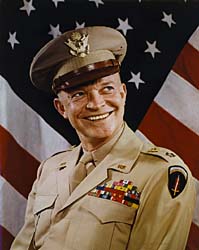

General Dwight D. Eisenhower was the closest any soldier ever came to being George Marshall's protégé. Eisenhower joined the General Staff in December 1941, and proceeded to excel at every leadership test to which the chief of staff could subject him. "George Marshall was rather a remote and austere person," recalled Ike, going by the nickname everyone in the army had used since he entered West Point. Marshall, however, always addressed him by his last name, and Eisenhower quickly discovered that Marshall's reputation for being all business was true in every respect.
Marshall especially valued Eisenhower's natural ability to get along with people. This was a major consideration in 1942, when he sought an American commander capable of melding with the British high command overseas. Eisenhower demonstrated his combat prowess by leading the Allies to their first victory in North Africa. When asked by the President who should become supreme commander in 1943, Marshall in effect deferred to Eisenhower by refusing to put his own name forward. Eisenhower became the war's most visible general, the one who methodically organized the D-Day invasion of France and who ultimately spearheaded the Allied victory over Germany. Eisenhower deserved his laurels, and Marshall was the first to congratulate him. Yet both men fully understood who had laid the cornerstone for his achievements.
Dwight D. Eisenhower, 1890-1969
BACK to "George C. Marshall: Soldier of Peace"
Harry Warnecke (1900-1984)
Color carbo print, 40.6 x 32.5 cm.
(16 x 12 13/16 in.), 1945
National Portrait Gallery, Smithsonian Institution
Gift of Elsie M. Warnecke
NEXT portrait